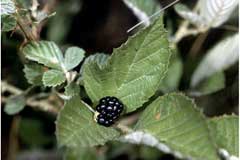Difference between revisions of "Rubus cuneifolius"
(→Ecology) |
(→Ecology) |
||
| Line 37: | Line 37: | ||
Flowering occurs between March and June, peaking in April.<ref name="Weakley 2015"/><ref>Nelson G. (6 December 2017) PanFlora. Retrieved from gilnelson.com/PanFlora/</ref> The timing of flowering has been shown to be sensitive to ozone levels where elevated levels cause earlier flowering but produce fewer large ripe fruits.<ref name="Chappelka 2002"/> | Flowering occurs between March and June, peaking in April.<ref name="Weakley 2015"/><ref>Nelson G. (6 December 2017) PanFlora. Retrieved from gilnelson.com/PanFlora/</ref> The timing of flowering has been shown to be sensitive to ozone levels where elevated levels cause earlier flowering but produce fewer large ripe fruits.<ref name="Chappelka 2002"/> | ||
<!--===Seed dispersal===--> | <!--===Seed dispersal===--> | ||
| − | + | ||
| + | ===Seed bank and germination=== | ||
| + | Seeds of ''R. cuneifolius'' were commonly observed in Georgia seed banks of longleaf pine - wiregrass - bracken fern forests maintained by annual spring burns since 1961.<ref>Buckner J. L. and Landers J. L. (1979). Fire and disking effects on herbaceous food plants and seed supplies. The Journal of Wildlife Management 43(3):807-811.</ref> | ||
<!--===Fire ecology===--> <!--Fire tolerance, fire dependence, adaptive fire responses--> | <!--===Fire ecology===--> <!--Fire tolerance, fire dependence, adaptive fire responses--> | ||
<!--===Pollination===--> | <!--===Pollination===--> | ||
Revision as of 19:57, 8 December 2017
| Rubus cuneifolius | |
|---|---|

| |
| Photo by Robert H. Mohlenbrock hosted at USDA NRCS Plants Database. | |
| Scientific classification | |
| Kingdom: | Plantae |
| Division: | Magnoliophyta - Flowering plants |
| Class: | Magnoliopsida - Dicots |
| Order: | Rosales |
| Family: | Rosaceae - Rose family |
| Genus: | Rubus - blackberry |
| Species: | R. cuneifolius |
| Binomial name | |
| Rubus cuneifolius Pursh | |

| |
| Natural range of Rubus cuneifolius from USDA NRCS Plants Database. | |
Common Name(s): sand blackberry[1][2], sand bramble, wedge sand blackberry[2]
Contents
Taxonomic Notes
Varieties: R. cuneifolius var. angustior; R. cuneifolius var. subellipticus; R. cuneifolius var. spiniceps[2]
Synonym(s): R. chapmannii; R. dixiensis
Description
Rubus cuneifolius is a dioecious perennial subshrub.[2]
Distribution
R. cuneifolius is found primarily on the coastal plains from Connecticut and New York south to Florida, Alabama, Mississippi and Louisiana.[1][2]
Ecology
Habitat
R. cuneifolius commonly inhabits woodlands, forests, and disturbed areas.[1] This includes early successional areas.[3]
Phenology
Flowering occurs between March and June, peaking in April.[1][4] The timing of flowering has been shown to be sensitive to ozone levels where elevated levels cause earlier flowering but produce fewer large ripe fruits.[3]
Seed bank and germination
Seeds of R. cuneifolius were commonly observed in Georgia seed banks of longleaf pine - wiregrass - bracken fern forests maintained by annual spring burns since 1961.[5]
Use by animals
Berries produced by R. cuneifolius are highly palatable by browsing animals, composing 10-25% of the diet for many species of terrestrial birds, large mammals and small mammals. It is also an occasional source of cover for small mammals and terrestrial birds.[2]
Diseases and parasites
R. cuneifolius hosts several species of thripes (Frankliniella spp.) which are tiny insects (1 mm or less) that feed on new plant growth producing cosmetic damage and sometimes transmitting diseases to the plant.[6]
Conservation and Management
Cultivation and restoration
Photo Gallery
References and notes
- ↑ 1.0 1.1 1.2 1.3 Weakley A. S.(2015). Flora of the Southern and Mid-Atlantic States. Chapel Hill, NC: University of North Carolina Herbarium.
- ↑ 2.0 2.1 2.2 2.3 2.4 2.5 USDA, NRCS. (2016). The PLANTS Database (http://plants.usda.gov, 30 November 2017). National Plant Data Team, Greensboro, NC 27401-4901 USA.
- ↑ 3.0 3.1 Chappelka A. H. (2002). Reproductive development of blackberry (Rubus cuneifolius), as influenced by ozone. New Phytologist 155-249-255.
- ↑ Nelson G. (6 December 2017) PanFlora. Retrieved from gilnelson.com/PanFlora/
- ↑ Buckner J. L. and Landers J. L. (1979). Fire and disking effects on herbaceous food plants and seed supplies. The Journal of Wildlife Management 43(3):807-811.
- ↑ Chellemi D. O., Funderburk J. E., and Hall D. W. (1994). Seasonal abundance of flower-inhabiting Frankliniella species (Thysanoptera: Thripidae) on wild plant species. Environmental Entomology 23(2):377-342.